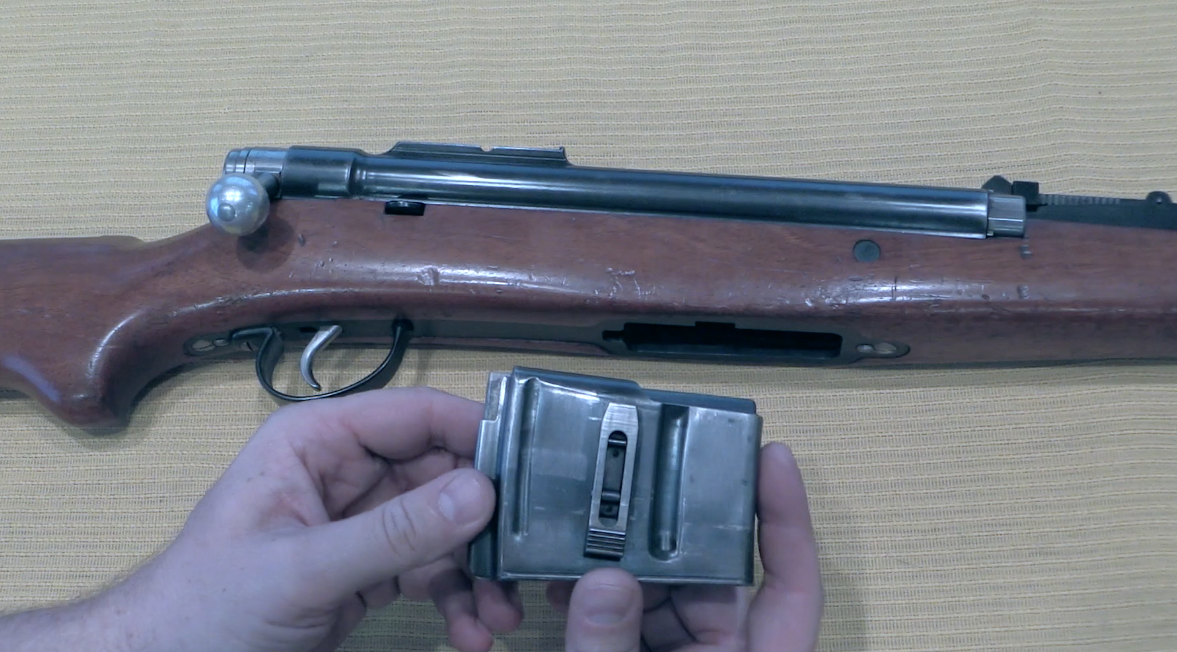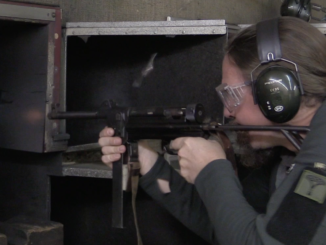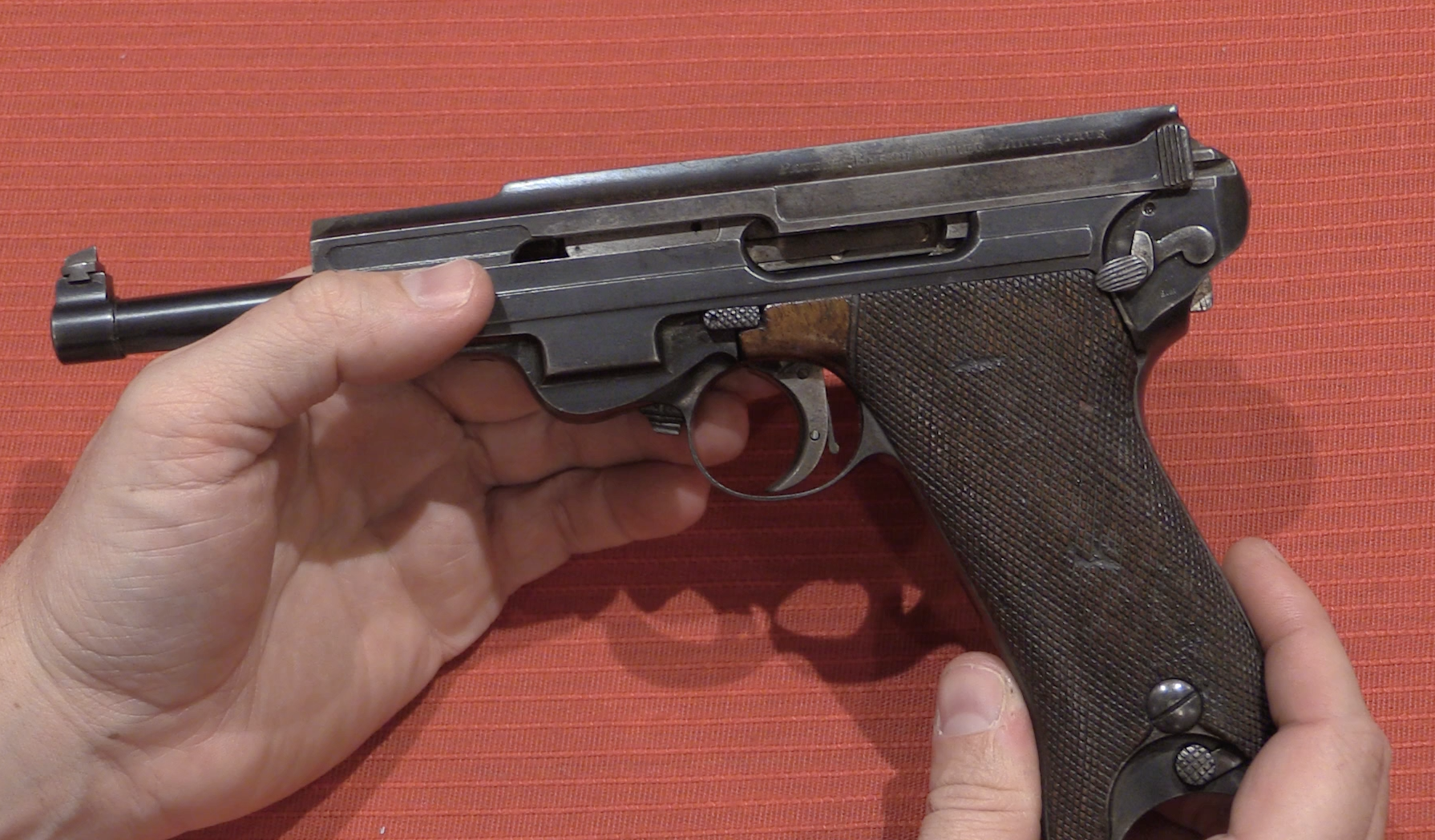Armament Research Services (ARES) is a specialist technical intelligence consultancy, offering expertise and analysis to a range of government and non-government entities in the arms and munitions field. For detailed photos of the guns in this video, don’t miss the ARES companion blog post.
The VP9 “Veterinary Pistol” (um…yeah) from Brugger & Thomet is a manually operated 9x19mm handgun with a quite effective suppressor built right onto the barrel. It is, in fact, a remarkably close copy of the British SOE Welrod pistol from World War II, right down to some pretty minor details.
The action uses a two-lug rotating bolt, which is unlocked and cycled by hand between shots. The magazine doubles as the grip, making for a compact and concealable package that would not necessarily be an obvious gun to the typical observer. The suppressor uses 4 rubber wipes which the bullet must actually make its own holes in – this makes it quieter than a typical suppressor, but only until the wipes have substantial holes shot through them (10 rounds or so). At that point the noise of each shot is still much quieter than a unsuppressed pistol, but not as quiet as when using new wipes. This is not a gun intended for a high volume of fire. That said, the suppressor body is easily removed, and the wipes are easily replaced.




If the gun is sold commercially then anyone could get it. A most terrifying thought for gun-control advocates, until one realizes that the item in question is ridiculously expensive and too special for street use. After all, only governmental agencies can buy large numbers of these! Or am I wrong?
“Veterinary Pistol”
Which seems to be pun intended against Mk 22 Mod 0 automatic silenced pistol, which was codenamed HUSHPUPPY.
Isn’t manual repeating silenced pistol outdated, if there is possibility to make weapons like Mk 22 Mod 0 which can work as manual repeat or automatic pistol?
Or they could be completely serious. See Humane Killer;
https://en.wikipedia.org/wiki/Captive_bolt_pistol
Replace the slotted “solid” wipes with ones with a 9mm diameter hole, add a 9mm diameter solid steel rod with sharpened end, and load it with 9 x 19mm full or double-load blanks, and rather than stunning a bullock, it would probably put the quietus to it permanently with one squeeze of the trigger.
cheers
eon
OUCH! Would this be about as quick a death and perhaps as painful as a 5 mL air embolism in the carotid arteries?
Quicker and painless. The muzzle is placed against the forehead just above the eyes, and when fired the steel bolt is projected about 6 inches (15cm), penetrating the skull and on into the brain.
The animal literally does not have time to realize that it’s dead.
There was even a murder mystery written involving a Humane Killer as the weapon. See The Unicorn Murders(1935) by John Dickson Carr, writing as Carter Dickson;
https://en.wikipedia.org/wiki/The_Unicorn_Murders
cheers
eon
The German NSU (national socialist terror organization) used a silenced .32 from Swizerland for murder. The pistol was legally bought in Swizerland by a fellow Swiss neo Nazi. Mind you, the Swiss have not gun registration, making it a hot spot for European criminals who need to acquire guns.
In Switzerland, special silenced rifle, dubbed G150:
http://modernfirearms.net/sniper/sniper-rifles/switch/g150-e.html
was created for usage by Project-26 in case of occupation of Switzerlind
It was bolt-action rifle firing .41 Magnum loaded with heavy bullets and having detachable box magazine for 3 rounds. Effective range to 200 m.
26.5 gm bullet @ 315 m/s translates in American to 408 grains @ 1,033 f/s. Interestingly, there are several large caliber(7.62mm to 12.7mm) pre-charged pneumatic rifles on the market today that can match this level of performance. For instance, the Air Force Texan Big Bore, in your choice of 7.62mm, 9mm, or 11.25mm;
http://www.pyramydair.com/s/m/AirForce_Texan_Big_Bore_Air_Rifle/3575
Any of which can achieve 1,100 f/s (335 m/s) MV.
It could be argued that for such operations, a PCP would be superior to any suppressed cartridge firing weapon, since an air gun can essentially fire any projectile which fits its bore, and thus is not dependent on an ammunition supply that could be limited, interdicted, or simply not available.
NB; This point was made as far back as the 1950s, by two science fiction writers. See Next of Kin by Eric Frank Russell and/or The Falling Torch by Algis Budrys.
cheers
eon
“It could be argued that for such operations, a PCP would be superior to any suppressed cartridge firing weapon, since an air gun can essentially fire any projectile which fits its bore, and thus is not dependent on an ammunition supply that could be limited, interdicted, or simply not available.”
How it does compare to G150 in terms of magazine capacity?
How does muzzle velocity spread presents – both from temperature and how much gas remain in tank?
How does it compare in accuracy?
1. Most PCP big bores are single hot, bolt-action.
2. The stock-mounted pressure cylinder holds enough air at 3000 PSI (2.0684e+7 pascal) for about 8-10 shots at full power. It can be removed and replaced in about the same amount of time it takes to reload a three-shot magazine.
3. After about 20 shots, MV will be down to around 500 f/s (150 m/s), with air supply exhausted at about 30 shots. temperature has some effect, as the airflow through the ‘snap’ value does generate some heat.
4. Accuracy is comparable to typical .22 RF rifles without sound suppression, meaning probably better than most suppressed weapons.
5. Effective range is roughly comparable to a typical blackpowder muzzleloading rifle due to caliber, projectile profile and MV, i.e., on the order of 100-150 meters.
Note that a modern .45 caliber PCP rifle will probably outshoot one of the PCP type rifles used by the Austrian army during the Napoleonic wars, if not in RoF at least in accuracy.
cheers
eon
Tactical hoof pick! LOL!
“Yet!” I can’t wait!
Aren’t user replaceable elements a big no-no under current ATF rules?
It’s currently not importable (last update on that status was in 2014 from B&T) so ATF rules don’t matter as the only people that can import it are LEO/MIL organizations in the US.
Right now the VP9 is only a curiosity for US-based shooters.
It’s easy to imagine some sort of covert role to these guns but realistically, no gov’t would want to send an assassin on a such a clumsy suicide mission nowadays when there are more sophisticated means to remove a troublesome personality.
There is a need in rural areas for vets (and field butchers) to quietly put down livestock. Often these sort of euthanasia devices don’t even have rifled barrels since they are contact weapons. Google “horse killers” which were devices used during WWI by cavalry vets to euthanize wounded animals.
Greener’s humane horse killer was reviewed by Iain a while since. https://www.forgottenweapons.com/ria-greeners-humane-horse-killer/ If a domestic animal has to be killed in a field or shed it is better for it not be loud enough to ‘frighten the horses’ but there is no point paying for a silent gun to do it!
I was going to mention Greener’s humane cattle killer too, but instead I’ll point out that while this device may indeed be intended for livestock, the more common solution is a Greener style captive bolt powered by compressed gas. For example the setup used by the villain in “No country for old men”.
It would more likely be used in a meat-packing plant/slaughterhouse. Of course there the usual captive bolt devices are powered by piped compressed air from an internal “shop” system much like the air wrenches at your local garage.
cheers
eon
Here’s what B&T’s website says;
Having seen the ruckus caused by police officers putting own injured animals ranging from deer to cattle, in both rural and suburban environments, I would say they at least have a good understanding of the potential market for this arm.
cheers
eon
” I would say they at least have a good understanding of the potential market”
Browsing through their site, I found weapon called USW:
https://www.bt-ag.ch/shop/eng/bt-usw/bt-universal-service-weapon–usw-a1-kal-9-x-19-bt-430001
which basically is automatic pistol with folding stock,
this remind me early automatic pistols, of which most known (but absolute not only) is Mauser C/96, with holster-stock.
It is described as 9×19 mm Browning system weapon.
It looks rather like a bizarre cross between Judge Dredd’s Lawgiver…
http://static.dudeiwantthat.com//img/entertainment/movie-props/judge-dredd-lawgiver-34-5073.jpg
… and an U.N.C.L.E. Special!
https://www.yourprops.com/movieprops/original/yp_5550de6f464920.93431436/The-Man-from-U-N-C-L-E-MGC-1967-UNCLE-Special-Carbine-1.jpg
cheers
eon
I guess if no one acknowledges making the Welrod, you don’t have to worry about them coming after you for copyright infringement.
Guns are not covered by copyright, which only covers “immaterial” products such as books, music or software. A gun could be protected by patents, but those would all be expired now even if they had been granted for the Welrod.
Also, any “device” made to a government specification cannot be patent-protected under U.S. law or most other nations’ laws. This is to allow contractor production of “devices” irrespective of originator, as in “lowest bidder gets the contract”.
Thus, various manufacturers built U.S. standard issue infantry small arms form the American Civil War onward. Which is why U.S. Springfield model 1861 rifle-muskets can be found with about a dozen different manufacturers’ names on the lockplate. Or Colt Model 1911-type .45 pistols were made by the likes of Remington-Rand (who usually made typewriters) during WW2.
Since the Welrod was developed “in-house” by the British Special Operations Executive, by definition the design is not legally “proprietary”.
cheers
eon
“A gun could be protected by patents, but those would all be expired now even if they had been granted for the Welrod.”
Additionally, for Germany and Austria, there exist Gebrauchsmuster:
https://de.wikipedia.org/wiki/Gebrauchsmuster
it is weaker than patent and expires faster
“gun could be protected by patents, but those would all be expired now even if they had been granted for the Welrod.”
B&T also produce MP9, for which they bought plans and rights from Steyr:
http://modernfirearms.net/smg/switch/b-t-mp-9-e.html
this weapon is improved Steyr TMP and might be described as compact sub-machine gun.